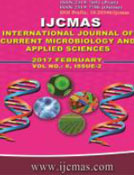


 National Academy of Agricultural Sciences (NAAS)
National Academy of Agricultural Sciences (NAAS)

|
PRINT ISSN : 2319-7692
Online ISSN : 2319-7706 Issues : 12 per year Publisher : Excellent Publishers Email : editorijcmas@gmail.com / submit@ijcmas.com Editor-in-chief: Dr.M.Prakash Index Copernicus ICV 2018: 95.39 NAAS RATING 2020: 5.38 |
A field experiment was conducted at Research-cum Instructional Farm, Indira Gandhi Krishi Vishwavidhyalaya, Raipur to study the Effect of tillage practices on growth, yield and economics of chickpea under rainfed condition of Chhattisgarh. The experiment was laid out in randomized block design with three replications and consisted of four tillage practices viz. T1- Zero tillage direct drilling of seeds and fertilizers at 2nd days after harvesting of rice, T2 -Minimum tillage and line sowing of seeds at 3rd days after harvesting of rice, T3-Minimum tillage at 6th days after harvesting of rice, T4-Farmer practice broadcasting seeds and fertilizer at 12th days after harvesting of rice. The results revealed that the significantly highest plant stand (32.67 plant m-2), plant height (43.08 cm), branches (11.57 plant-1) dry biomass (12.81 g plant-1), pods plant-1 (28.34), seed and stover yield (11.35 and 18.28 q ha-1, respectively) has been superior under minimum tillage and line sowing of seeds at 3rd days after harvesting of rice. However, it was found statistically similar with treatment zero tillage direct drilling of seeds and fertilizers at 2nd days after harvesting of rice but, seed index and harvest index was not significantly varied by tillage practices. Similarly, gross return (Rs 36951 ha-1) was also higher under minimum tillage and line sowing of seeds at 3rd days after harvesting of rice, but net return (Rs 24280 ha-1) and B:C (2.96) ratio were highest under ZT.
 |
 |
 |
 |
 |